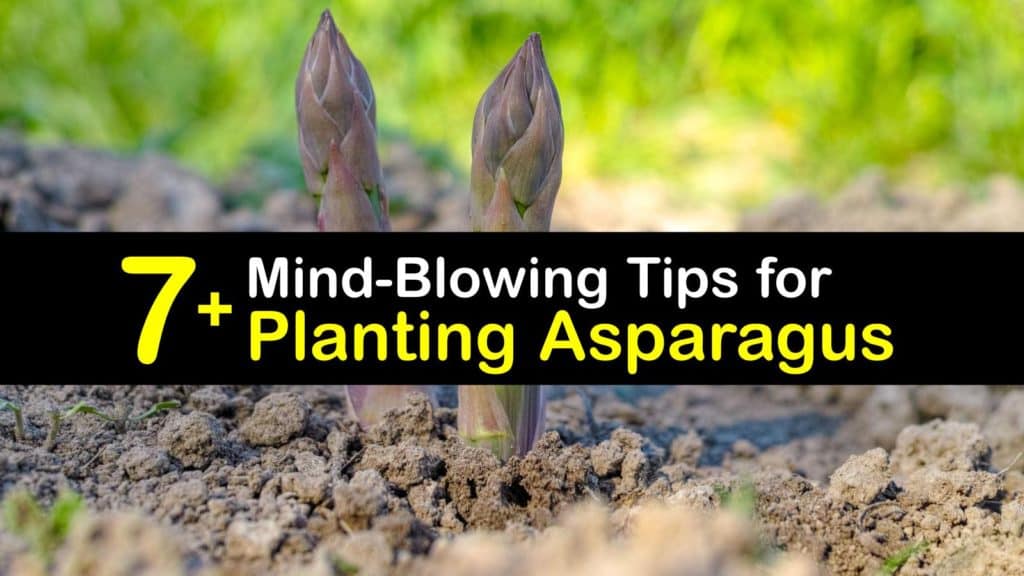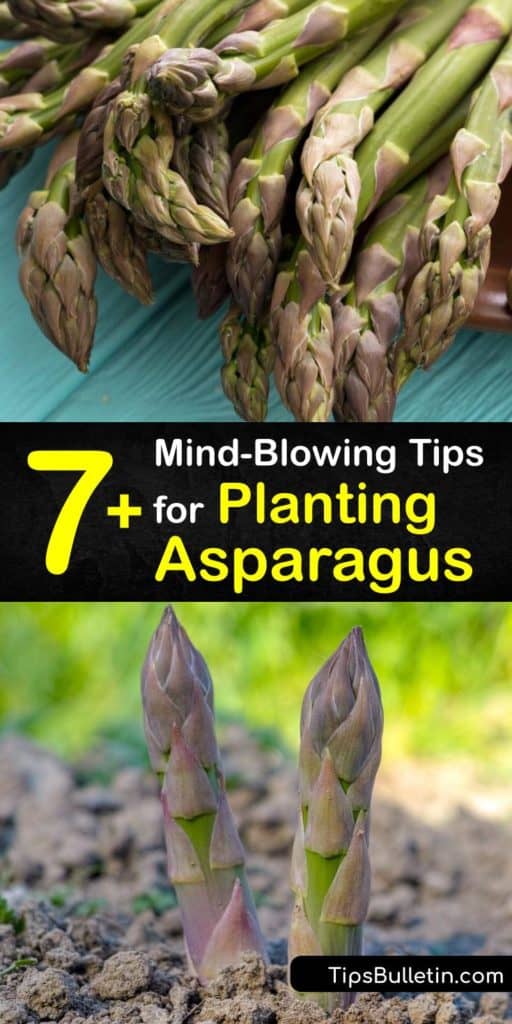Asparagus is a crisp veggie that pairs well with steak, pasta, and many other mouthwatering dishes. It isn’t the most popular plant to grow at home, but it’s well worth the work when you get to harvest them fresh and turn them into something tasty. Knowing when to plant asparagus is the first step in growing these delicious spears, but tons of other tips help these veggies thrive in your garden.
Whether you have questions about the asparagus growing season or are interested in asparagus companion planting, every grower has been in a position where they had to learn all about asparagus, how to grow it, and how to have a flourishing harvest of healthy plants.
If you’re ready to take on a new challenge and start your own asparagus bed, read these tips to successfully grow asparagus as a first-timer.

Why Grow Asparagus?
Believe it or not, asparagus is a close family member to lilies. There are many varieties of asparagus, and they range in color from green to white and even purple. Explore the advantages of planting white vs green asparagus to determine which types will work for your family.
The most significant benefit to eating asparagus is that it is low in calories while remaining high in nutrition.
Half a cup of asparagus has less than 20 calories while being packed with over two grams of protein and fiber. It also contains over 55 percent of vitamin K and high levels of vitamins A and C.
The number of antioxidants in asparagus is high and helps protect all the cells in your body to prevent inflammation and diseases like cancer.
Purple types, like Purple Passion asparagus, contain the highest levels of antioxidants. Asparagus improves digestion, lowers blood pressure, and is a tasty addition to anyone’s diet.
Everything You Need to Know about Planting Asparagus
If you’re a beginner and this is your first year growing asparagus, you’re probably filled with questions and want to know when to plant asparagus and what to plant with asparagus. Try starting with Mary Washington or Martha Washington asparagus types.
These kinds were developed in the 1900s to be more resistant to common diseases like asparagus rust. The alterations make it easier for your asparagus plants to survive and give you a bountiful harvest.

When is Asparagus Growing Season?
Unlike a lot of other garden vegetables, asparagus is a perennial vegetable and comes back every year. During the asparagus growing season, new shoots appear in the spring and last until early summer.
They require some time to mature before harvesting and are a commitment if you truly want to utilize them in your kitchen. Asparagus may last as long as 30 years if raised under the right conditions.
When to Plant Asparagus
Like many other plants, knowing when to plant asparagus is one of the most critical factors of a successful harvest. The best time to plant asparagus is either early spring or fall, whether you are growing asparagus from seed or crowns.
Remember that new shoots emerge in the spring, so it might be easier for some people to plant them during autumn to tend to the stalks the following spring.
How Much Asparagus Should You Plant?
It’s hard to know how much asparagus you should plant to provide your family with enough of the crop for the year.
Start by planting ten plants for each family member. Every plant yields roughly half a pound of spears per harvest. Adjust the number of plants based on how often you plan to cook with them.
How to Plant Asparagus
Another major factor for growing healthy asparagus spears is to choose a location that fits all their needs. Pick an area in your yard or garden that receives full sun or at least six hours of direct sunlight every day.
Try to place them around the edge of your beds where they have minimal disturbance from your other planting activities. Asparagus crowns do not tolerate high acidity. Check to make sure the soil pH level is between 6.5 and 7.0 before moving any further.
Before you go shopping at your garden center, prepare the beds by mixing in a few inches of organic fertilizer or organic matter, like compost, aged leaves, or Epsom salts. The compost’s nutrients enrich the soil so that each plant has enough to have a strong start. Learn more about fertilizer made from Epsom salt for asparagus plants to add the nutrients that they require.
The soil must also have good drainage. Planting your asparagus in a raised bed is a great way to ensure that the soil moisture remains healthy but growing them at ground level is also acceptable.
When shopping, choose between male and female asparagus. Male plants are ideal because they often grow larger than female plants and have higher production levels.
Jersey Giant and Jersey Knight varieties are some common types that give plenty of grower success. Once your beds are prepped, dig up six to eight inches of soil to create a trench after the dangers of frost are gone.
Set each seedling into the lowest part of the channel and space each one about 15 inches apart. Asparagus roots are contractile and pull the crowns downward to a spot they like. The root system gets huge after several years.
If the seedlings are too close together, the new asparagus is only produced for a few years, while more spacing helps them last for decades. Cover your seedlings with the soil and water them until the earth is moist.
Why You Should Regularly Mulch and Water
Mulching is vital for plants because it helps retain soil moisture during the hot summer months, protects the roots during the winter, and helps control weeds. Mulch the asparagus patch and keep it weed-free.
Weeding stops other plants from taking over the beds and sucking all the nutrients out of the soil. Common perennial weeds to look out for are dandelions, ivy, and dallisgrass.
Give the asparagus plants one to two inches of water per week during the first and second year. Older plants only require about one inch of water every week.
When to Harvest Asparagus
You might be impatient to harvest spears, but you won’t enjoy them during the first year or even the following year. The best time to harvest spears is during their third year of life. Asparagus needs time to mature.
Although it’s safe to eat them during the second year, you’ll be gifted with tastier crowns if you hold off until the third. Asparagus is ready to harvest once each shoot reaches about eight inches tall. Snap the shoots off at the soil line or use a knife to cut them.
Avoid damaging emerging spears that are close by. If the shoots are open and developing foliage, the asparagus is too tough to consume.
Plan to harvest every other day, so you don’t wait too long and miss out on yummy meals. When the spears’ diameter is about the same size as a pencil, it is time to stop harvesting and let them rest until next spring.
Asparagus Companion Planting
Some plants work well together, and others don’t. Asparagus companion planting is beneficial because you can grow plants that add nutrients to the soil, aid in water retention, repel pests and diseases, and even welcome beneficial insects.
Tomatoes are smart choices for asparagus companion planting. Tomatoes produce a chemical called solanine that repels pests like asparagus beetles. The asparagus helps the tomatoes by emitting a chemical that deters nematodes.
Asparagus is a great companion plant for strawberries. If you like both, you’ll have a fabulous harvest.
Herbs like parsley and dill are some other great choices to plant with asparagus. Some herbs repel insects like spider mites and keep them from feeding on your spears.
On the other hand, some plants don’t like being placed next to one another. Keep garlic, onions, and potatoes away from your asparagus. These plants stunt the growth of the spears and ruin your harvest.
Asparagus Pests and Diseases
Location, weather, moisture, and other factors all create issues with pests and diseases. Fusarium wilt is one fungus to look out for. Fusarium wilt stunts productivity and turns the asparagus spears light yellow with a brownish-red colored base.
Try minimizing any stress the plant is facing and stop harvesting the plants if production noticeably declines. Cutworms are a pest that asparagus has to face frequently. These worms look like caterpillars and are yellow or brown.
The larvae feed on the tips of new and old crowns at night. The small areas they eat cause the shoots to curl. Keep weeding and add an insecticide if necessary.
What to Make with Asparagus
Roasted asparagus is a common side dish that families love, but eating them the same ways over and over gets a little boring.
Asparagus pickles are a zesty and healthy treat. It gives the asparagus a unique flavor, and they make a great addition to a bloody Mary.
Bring the two cups of water, vinegar, salt, and sugar to a boil in a saucepan. Remove the asparagus brine from the heat and let it cool slightly. Split the garlic, mustard seeds, and dill between two sterile canning jars.
Tightly pack the blanched asparagus spears into the canning jars and then pour the brine in each glass jar. Secure the lids and put the jars in the refrigerator for two weeks before eating them. Store the asparagus pickles in the fridge for up to two months.
You’re one step closer to growing your own asparagus at home. With information on the asparagus growing season, asparagus companion planting, and all the other requirements for growing these crisp veggies, it’s time you start preparing your garden to embrace a new veggie.
Asparagus isn’t a common plant to grow at home, but there’s nothing better than walking outside, cutting a few stalks, and bringing them inside to turn them into a savory dinner.

If learning when to plant asparagus has helped you produce an abundant harvest, share these tips for growing asparagus on Facebook and Pinterest.